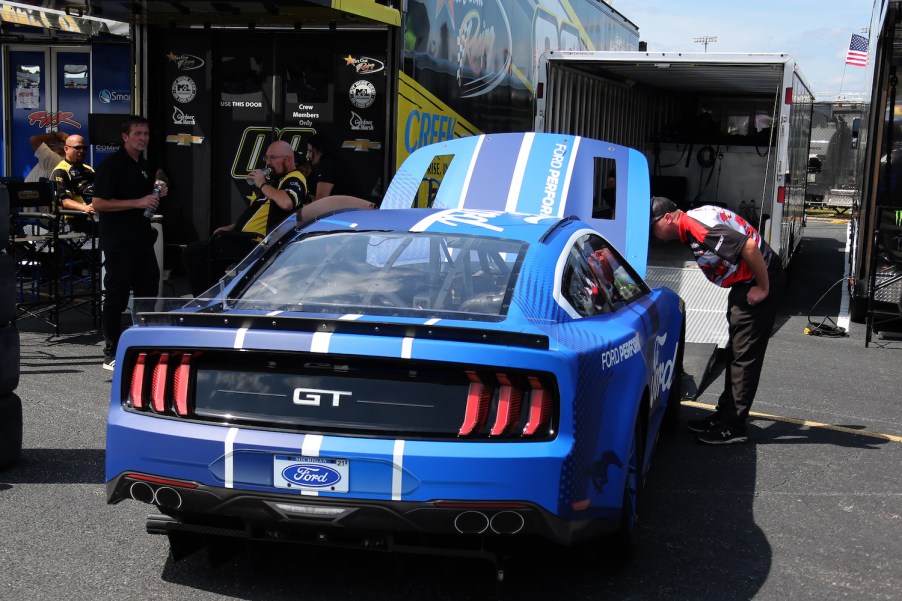
NASCAR Next Gen Engines Make Much More Horsepower
United States stock car racing is steeped in tradition. For example, naturally-aspirated pushrod V8s still power NASCAR Cup cars. But times do change. While NASCAR’s basic engine layout is not going to change anytime soon, 2022’s Next Gen cars will make hundreds more horsepower than the outgoing NASCAR cars.
NASCAR Uses V8 Engines

Many modern engines make power with turbochargers and variable valve timing. But NASCAR’s motto might as well be “there’s no replacement for displacement.” For example, naturally-aspirated iron block V8s drive these stock cars.
NASCAR limits stock car engines to 358 cubic inches (5.86 liters) of displacement. There are no overhead cams at NASCAR events. Instead, traditional pushrods operate these V8s’ two valves per cylinder.
Each NASCAR team is allowed to build 13 engines for each NASCAR Cup season. A full season, with exhibition races, includes 36 race weekends. Each team much use each one of their engines at least two times. They cannot swap to a fresh engine during a single weekend: if they qualify for a race with one engine, they can only keep the position they have qualified for by racing with the same engine.
The teams and OEMs building V8s for NASCAR have refined their technique over the decades. Today, these engines spin at 9,000 RPMs for the entire length of 500-mile races. NASCAR has also allowed fuel injection for modern Cup engines. Though the teams originally based these engines on the powerplants of Detroit’s classic muscle cars, they have steadily increased the power output.
Drivers usually reach some of their fastest speeds on the 2.6-mile Talladega Superspeedway. In 1987, Bill Elliott broke the Talladega record by driving 212.809 mph during qualifying. Then, during the ’87 race, Bobby Allison went airborne and flew off the track, nearly crashing through a grandstand full of spectators. After that, NASCAR officials knew it was time to slow the cars down.
Restrictor Plates Limit Old NASCAR Engines To 410 Horsepower

NASCAR fans attend races to witness exciting, bumper-to-bumper racing. After the 1987 crash nearly killed a grandstand full of fans, NASCAR officials decided that 212 mph was too fast for the sport. They knew the races had been exciting at 190 mph and would continue to be exciting if they limited every car’s speed. They also knew that the new, higher speeds put fans at risk.
The Association first experimented with requiring all teams to use smaller carburetors. Eventually, NASCAR settled on restrictor plates instead. A restrictor plate is a 1/8th-inch thick aluminum plate with four holes. The plate limits the amount of fuel/air mixture that can enter the engine. Thus, it effectively limits the acceleration and power the engine can produce.
Every team must bolt an official restrictor plate to the intake manifold of their engine. NASCAR has continued to use the same restrictor plate dimensions for 31 years. The plate limits the NASCAR V8 engines–theoretically capable of making 850 horsepower–to approximately 410 horsepower.
NASCAR Next Gen Cars Will Create More Downforce–And Drag

For the 2022 NASCAR Cup season, the association will replace the sixth-generation stock cars with Next Gen stock cars. The new Next Gen cars will be much more similar to stock cars than the outgoing race cars. The new cars will feature symmetrical bodies, even on oval tracks. They will have taller spoilers and aggressive, stepped front splitters to create much more downforce.
This additional downforce will allow drivers to corner tighter and pass more often. It will also limit the cars’ top speed. For Next Gen cars to be as fast as sixth-generation cars, NASCAR needed to increase engine power.
As NASCAR officials searched for ways to increase the Next Gen cars’ power, they discovered a problem with the restrictor plates. Restrictor plates with straight intake holes created unnecessary turbulence. As a result, when the gas/air mixture hits the right angle between the restrictor plate and intake hole, it swirls instead of entering the manifold.
When engineers machined intakes with just a seven-degree taper, they found the new cone-shaped openings were a nozzle. Replacing traditional restrictor plates with tapered spacers exponentially increased the amount of air that entered the engine and thus increased the stock car’s horsepower.
The NASCAR Next Gen Engine Will Make 670 Horsepower

For the 2022 season, NASCAR officials have created two aerodynamics/engine “packages” for NASCAR spec cars. The Superspeedway package for Talladega and Daytona includes a seven-inch spoiler and 510 horsepower restrictor plates.
The package for every other medium track and road course includes a four-inch spoiler and aggressive aerodynamic elements offering up to one thousand pounds of downforce. In addition the package comes with a “tapered spacer” to replace the restrictor plates.
The tapered spacer is an aluminum plates about an inch thick. Instead of straight holes, it has tapered holes that funnel more air and gas into the engine than restrictor plates. The tapered spacer will allow the same V8 engine to make 670 horsepower. A new Corvette-style transaxle will transfer this additional power to the wheels.
Thanks to the added power and increased downforce, 2022 is shaping up to be one of the most exciting NASCAR Cup seasons in years.



